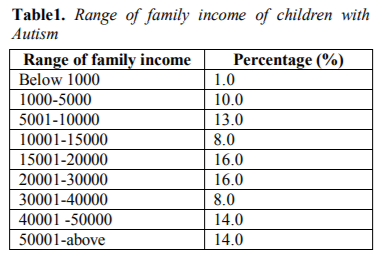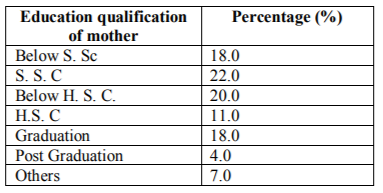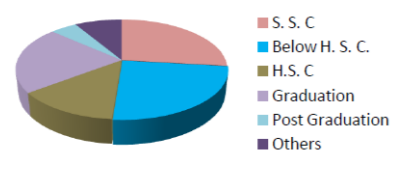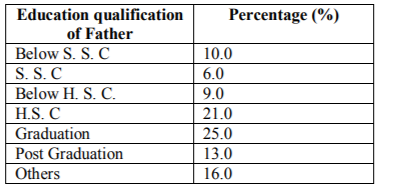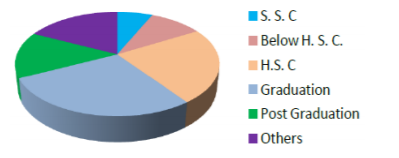Information
Journal Policies
Parental Educational Background and Socio Economic Status of ASD children in Bangladesh
Sadia Afrin1*,Mir Ayesha Akter1,Sajani Akter2,Tanmi Akhter1,Dr.Prof Shaheen Akhter3
2.Counselor, Institute of Paediatric Neurodisorder and Autism, Bangabandhu Sheikh Mujib Medical University, 2nd floor, Block E, IPNA, BSMMU, Shabag, Dhaka, Bangladesh.
3.Project Director, Institute of Paediatric Neurodisorder and Autism, Bangabandhu Sheikh Mujib Medical University, 2nd floor, Block E, IPNA, BSMMU, Shabag, Dhaka, Bangladesh
Copyright :© 2017 Authors. This is an open-access article distributed under the terms of the Creative Commons Attribution License, which permits unrestricted use, distribution, and reproduction in any medium, provided the original author and source are credited.
Bangladesh is a developing country where most of the people live in under a minimum level of EB and SES. Nowadays Autism is a growing condition in our country. The present study assessed the Educational background and Socio–Economic status of Parents of ASD child. A total of 200 parents of 100 children with ASD (2-8 years old) were conveniently selected to collect data from existing data source of IPNA. Result shows that the incomes of most of the family of children with ASD are between 15000-30000 ranges. Mothers of children with Autism are studied up to only S. S. C. level where father’s educational level is Graduation. We all know that mothers are the first instructor of the child, so EB effects on handling the ASD child, parental counseling and instruction for management. For collecting management tools SES is a very important factor also.
Autism spectrum disorder (ASD), Socio-economic status (SES), Educational background (EB),Psychiatry
A noted neurological and developmental disorder is Autism Spectrum Disorder (ASD) that commences aforetime in childhood and lasts throughout a person's life. ASD affects how a person conducts and interacts with others, convey, and learns. Because of people with ASD can have an extent of symptoms it is known as spectrum disorder. Person with ASD might have problems verbalizing with someone or they might not look other in the eye when someone talks to them. They may also have curtailed stakes and insistent behaviors. They may outlay a lot of time putting things in order, or they may say the same word or sentence or meaningless sound again and again. They may often seem to be in their "own world." Generally, person with autism exhibit a unique set of symptoms in three areas: socialization, communication and behavior according to different types of autism assessment tools like Autism Diagnostic Check List (ADCL) [1], Autism Diagnostic Observation Schedule (ADOS) etc. Most of the research shows that population indicators of socioeconomic status (SES), such as household wealth or income and parental education and occupation, are strongly correlated with the health and development of children. In the case of autism and autism spectrum disorder (ASD), evidence for an association with Socio-Economic Status (SES) has been mixed and more often in the opposite direction of that for other childhood disorders. It is a sociological truism that social status not only affects one’s life chances but also including one’s health. This generates the negative socioeconomic (SES) health gradients that have been identified for a broad array of conditions ranging from infant mortality to heart disease (Pamuk et al. 1998) [7]. The persistence of health gradients across time and in different contexts has given rise to the idea that SES status itself is a fundamental cause of health (Link et al. 1998 [5]; Link and Phelan 1995 [4]).
Autism diagnoses have always been based solely on presentation. Families with low socioeconomic status often lack the financial, social and educational supports that characterize families with high socioeconomic status. In preschool low maternal education and minority-language status are most consistently associated with fewer signs of emerging literacy and a greater number of difficulties. Having inadequate resources and limited access to available resources can negatively affect families' decisions regarding their young children's development and learning. Therefore, researchers conducted this study that was aimed to find out the relationship of socio-economic factors and educational back with autism in Bangladesh. Fujiwara, T. [3] studied on the association between family socioeconomic status (SES) and the suspected autism spectrum disorder (ASD) status of 18-month-old toddlers was investigated using a population-based sample in Japan, Questionnaires including SES measurements and modified checklist for autism in toddlers were mailed to all families with 18-month-old toddlers in Chiba, a city near Tokyo (N = 6,061; response rate: 64%). The results of logistic regression analysis (which were adjusted for potential confounders) indicated that low maternal education, but not paternal education or family income, were associated with having suspected ASD offspring. Lower maternal education was associated with an increased risk of autistic traits in Japan. Hasnain MG, Akter M. (2014) [4] studied on The Relation of Socio-economic Factors with Autism among Children: A Study in an Urban Area of Bangladesh, All the subjects of the study are the parents of autistic children who were educated and living in Dhaka, the highest numbers of autistic children were aged 7-9 years (32%) and 4-6 years (28%); 78% were male and 22% were female children. With respect to birth order, 58% were first born and 33% were second born. Parents’ education and occupation were associated with this disorder but family income was not. Autistic children were more likely to have illiterate parents (32%) followed by parents with primary level education (21%). The majority of the patients (87%) were from nuclear families and 66% were from urban areas. On the other hand, only 38% of the children went to school regularly. Rai D et. Al. (2012) [9] studied on Parental socioeconomic status and risk of offspring autism spectrum disorders in a Swedish population-based study. The objective of this study was parental SES would be associated with an increased risk of offspring ASD, once biases in case ascertainment are minimized. The sample were matched ASD cases (n = 4,709) by age and sex to 10 randomly selected controls. We retrieved parental SES measures collected at time of birth by record linkage. Result shows that Children of families with lower income, and of parents with manual occupations (OR = 1.4, 95% CI = 1.3-1.6) were at higher risk of ASD. No important relationships with parental education were observed. These associations were present after accounting for parental ages, migration status, parity, psychiatric service use, maternal smoking during pregnancy, and birth characteristics; and regardless of comorbid intellectual disability.
2. Materials And Method
The population of this study is parents of children with ASD in Bangladesh, child age range is 2-8 years old. 100 ASD children’s parents who are different places of Bangladesh were selected by convenient sampling techniques from the existing data source of Institute of Pediatric Neuro-Disorder and Autism, Bangabandhu Sheikh Mujib Medical University. The age range of the child is 2-8 years old in 2012 to2014 years; researcher does not mention any age limitation for parent’s age. Data were collected randomly from the IPNA, BSMMU. From these sources – IPNA, BSMMU Hospital record.
1. Personal interview, Parent’s historical background from ADCL data sheet and behavioral therapy.
3. Procedure
To collect the data researcher interviewed the parents of children with ASD who were come to IPNA, BSMMU for assess their child’s level of autism and also for management. Data were collected individually from the respondents. The participants were interviewed verbally and ensured that they had understood the question. The respondents were told that the information given by them would be kept confidential and would be used for research purposes only. Each interview took half an hour in average. On the completion of the task, each participant was thanked for their cooperation.
4. Results And Discussion
This research conducted to see the Socio-Economic and Educational background of Parents of ASD child. The result of this research is presented in table format.
Table 1 shows the range of family income of children with Autism. In order to the range of income, here we see that 1% children’s family income is below 1000, 10.0% children’s family income is in 1000-5000 thousand, 13.0% children’s family income is in 5001-10000 thousand, 8.0% children’s family income is in 10001-15000 thousand, 16.0% children’s family income is in 15001-20000 thousand, 16.0% children’s family income is in 20001-30000 thousand, 8.0% children’s family income is in 30001-40000 thousand, 14.0% children’s family income is in 40001-50000 thousand, 14.0% children’s family income is Above 50001 thousand.
Table 2 shows the percentage of the educational qualification of mother of children with autism. Here the percentage of mother of below S. S. C. is 18.0%, in S.S.C. level is 22.0%, in below H. S. C is 20.0%, in H. S. C. level is 11.0%, in Graduation level is 18.0%, in Post Graduation level is 4.0% and Others are 7%.
Table 3 shows the percentage of the educational qualification of father of children with autism. Here the percentage of father of below S. S. C. is 10.0%, in S.S.C. level is 6.0%, in below H. S. C is 9.0%, in H. S. C. level is 21.0%, in Graduation level is 25.0%, in Post Graduation level is 13.0% and Others are 16%.
5. Discussion
This study assessed the Socio–Economic and Educational background of Parents of ASD child. A total of 200 parents of 100 children with ASD (2-8 years old) were conveniently selected to collect data from existing data source of IPNA. The Rationale of the study is to increase the awareness about ASD and continue the management techniques which are depend on parent’s EB. Study shows that EB is almost related to SES, so improving awareness about Autism and continuing management we need to identify the parent’s background (SES, EB).
Parental Counseling and management instruction are also depending on parent’s EB. The tools which are used in different management techniques are also costly for their income range. So in this study if researcher can find that most of the parents of children with ASD then it’s high time to counseling parents to increase awareness among the population of low educational background and developing low cost materials for population of lower socio economical status. These are the data collection tools which were collected randomly from the IPNA, BSMMU- IPNA, BSMMU Hospital record, Personal interview, Parent’s historical background from ADCL sheet, Parent’s historical background from behavioral therapy.
The findings of the present study (table 1) indicate that most of the family’s (children with ASD) income range is 15000-30000 tk per month. That indicates most of the children with ASD belongs to medium earning family.
Other two important findings presented in table 2 and 3 showed that mother of children with ASD are less educated than father. This result supports the finding the findings of previous study by Hasnain MG, Akter M. (2014)[4] found that autistic children were more likely to have illiterate parents (32%) followed by parents with primary level education (21%).
SES and EB have a very effective role on parents to handle the children with autism. Most of the cases found that education and economically solvent person can easily understand and feels the problem of ASD child for this reason they can realize the child’s situation and be with the child. They can help other parents for immediate/early management because they can find that as soon as management starts as more as child can progress their activities. Educated parents are more aware about the ASD service center/ Special Schools/ where the services are available than less educated parents. Parent counseling are more effective for educated person, they can easily maintain the ASD management rules & procedures as scientifically. Many economic solvent families had no education in that case they are not conscious about ASD child. Again many educated family or person had awareness but for the economic lacking they can’t bear the management cost for this reason they have to stop the procedure. Education can protest the social pressure and stress, when parents know that they has a special child or autistic child they face a social question and pressure, educated parents can handle the situation strongly and face the society but an uneducated parents cannot face it and they have broken down and try to hide the child and also avoid the child with ASD. Now it’s high time to make awareness not only to educated person but also to less educated one. This study shows that most of the children belong to less educated family so we have to make such process by which we can aware uneducated one and counseling them to make mentally strong. Most of the management techniques are imported for this reason tools are much costly, so to see the family income of children with ASD now we need to adapt the tool for our economical status.
The main reason to know the parents socio – economic and educational background is to identify the background of the population. Not only we want to involve the higher or middle class population in awareness program or management progrem but also all class of population will be involved. We want to give the messages in all level that we work for progress not for perfection.
References
- Banerjee, M (2007)- Autistic Diagnostic Check-List – Indian Journal of Clinical psychology, 34(1),83-93
- CHANG VW, LAUDERDALE DS. Fundamental Cause Theory, Technological Innovation, and Health Disparities: The Case of Cholesterol in the Era of Statins. Journal of health and social behavior. 2009;50(3):245-260.
- Fujiwara, T. (2014). Socioeconomic status and the risk of suspected autism spectrum disorders among 18-month-old toddlers in Japan: A population-based study. Journal of Autism and Developmental Disorders, 44(6), 1323–1331.
- Hasnain MG, Akter M The relation of socio-economic factors with autism among children: A study in an urban area of Bangladesh, Journal of Pioneer Medical Science,volume , issue 1, pages 11-13.
- Link, Bruce G. and Jo C. Phelan. 1995. “Social Conditions as Fundamental Causes of Disease.” Journal of Health and Social Behavior (extra issue):80–94.
- Link, Bruce G., Mary E. Northridge, Jo C. Phelan, and Michael L. Ganz. 1998. “Social Epidemiology and the Fundamental Cause Concept: On the Structuring of Effective Cancer Screens by Socioeconomic Status.” The Milbank Quarterly 76:375–402.
- Md. Golam Hasnain1, 2, Monjura Akter, The Relation of Socio-economic Factors with Autism among Children: A Study in an Urban Area of Bangladesh - See more at: http://www.jpmsonline.com/jpms-vol4-issue1-pages11-13-oa.html#sthash.MgbuU1fY.dpuf, Journal of Pioneering Medical Sciences, Volume 4, Issue 1 (January-March, 2014)
- Pamuk E, Makuc D, Heck K, Reuben C, Lochner K. (1998.) Socioeconomic Status and Health Chartbook. Health, United States, 1998. Hyattsville, Maryland: National Center for Health Statistics.
- Rai, D., Lewis, G., Lundberg, M., Araya, R., Svensson, A., Dalman, C. Magnusson, C. (2012). Parental socioeconomic status and risk of offspring autism spectrum disorders in a swedish population-based study. Journal of the American Academy of Child and Adolescent Psychiatry, 51(5).
- Rutter, M., DiLavore, P. C., & Risi, S. (2002). Autism diagnostic observation schedule: ADOS. Los Angeles, CA: Western Psychological Services.





